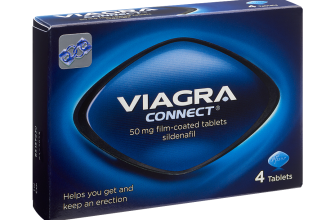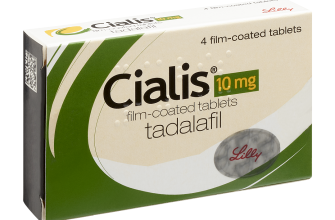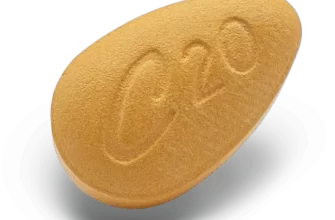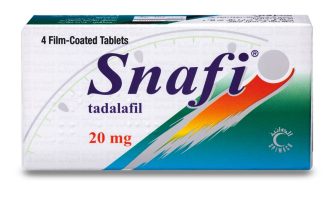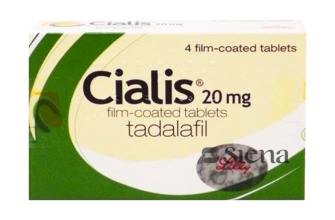The half-life of Viagra (sildenafil) is approximately 4 hours. This means that after taking a dose, half of the medication’s active ingredients will be eliminated from the body within this time frame. Understanding this can help you plan your dosage schedule effectively.
Factors influencing Viagra’s half-life include age, health conditions, and other medications. For instance, individuals with liver or kidney impairments may experience a prolonged half-life due to slower metabolism and clearance rates. Always consult with a healthcare professional if you have concerns about these aspects.
For optimal efficacy, it is recommended to take Viagra about 30 to 60 minutes prior to sexual activity. The drug’s effects can last up to 4 to 5 hours, providing a suitable window for intimacy. Keep in mind that sexual stimulation is necessary for the medication to work effectively.
Adjusting your dosage should only be done under a healthcare provider’s guidance. Regular monitoring ensures safety and maximizes the potential benefits of Viagra. Maintaining open communication with your doctor will allow for tailored advice based on your unique situation.
- Half-life of Viagra
- Understanding the Half-life Concept in Medications
- How Half-life Affects Dosing
- Factors Influencing Half-life
- Pharmacokinetics of Viagra: Key Factors Affecting Half-life
- 1. Absorption and Bioavailability
- 2. Age and Metabolism
- 3. Dosage and Frequency of Use
- 4. Interactions with Other Medications
- Average Half-life of Viagra: What the Research Says
- Factors Influencing Half-life
- Clinical Implications
- Factors Influencing the Half-life of Viagra in Individuals
- Metabolism Rate
- Drug Interactions
- How Half-life Affects the Efficacy of Viagra Dosing
- Comparing Half-life of Viagra with Other ED Medications
- Practical Implications of Viagra’s Half-life for Users
Half-life of Viagra
The half-life of Viagra, or sildenafil, is approximately 4 to 5 hours. This means that the concentration of the drug in the bloodstream decreases by half during this period. For most individuals, the effects of Viagra can last up to 4 hours, although this varies depending on factors such as metabolism, age, and overall health.
Dosage timing is important. Taking Viagra about 30 to 60 minutes before sexual activity optimizes its effectiveness, as this allows the body to reach adequate levels of the drug. If more than one dose is taken within a 24-hour span, the chances of experiencing side effects may increase due to cumulative levels in the system.
Alcohol and heavy meals can also impact the duration and effectiveness of Viagra. It’s advisable to limit alcohol intake and avoid large meals close to the time of taking the medication, as these factors can slow absorption and affect onset time.
Individuals using Viagra should consult with their healthcare provider for personalized advice, especially if they have underlying health conditions or take other medications that may interact with sildenafil. Understanding these nuances ensures safer and more effective use of Viagra.
Understanding the Half-life Concept in Medications
The half-life of a medication is a key factor in determining how long its effects last in the body. For Viagra, the half-life is approximately 4 to 5 hours, which means that after this period, half of the dose has been eliminated from the bloodstream. Knowing this helps you anticipate when the medication will peak in effectiveness and when it will begin to wane.
How Half-life Affects Dosing
Understanding half-life can aid in effective dosing strategies. For Viagra, taking it about 30 minutes to an hour before sexual activity allows for optimal effectiveness, as the drug reaches its peak concentration within that timeframe. If you’re considering using Viagra, plan accordingly to enhance your experience.
Factors Influencing Half-life
Various factors can influence the half-life of Viagra, including age, metabolic rate, and kidney function. Older adults or individuals with impaired kidney function may experience a longer elimination time, which could alter the medication’s duration and intensity of effects. Always consult with a healthcare provider to ensure safe and optimal use.
| Factor | Effect on Half-life |
|---|---|
| Age | May increase half-life due to slower metabolism |
| Kidney Function | Impaired function can prolong elimination |
| Metabolic Rate | Higher rates can decrease half-life |
By grasping the half-life concept, you can make better-informed decisions about using Viagra and discuss any concerns with your healthcare provider for personalized advice.
Pharmacokinetics of Viagra: Key Factors Affecting Half-life
The half-life of Viagra (sildenafil) is approximately 4 hours, but various factors can influence this duration. Understanding these factors can enhance the effectiveness and safety of the medication.
1. Absorption and Bioavailability
The rate at which Viagra is absorbed into the bloodstream significantly affects its half-life. Take it on an empty stomach to ensure quicker absorption. High-fat meals can delay absorption, prolonging the onset of action and potentially altering half-life.
2. Age and Metabolism
- Older adults may experience a longer half-life due to decreased metabolic rate.
- Individuals with liver impairments or conditions affecting liver function can exhibit increased half-life, leading to higher drug concentrations in the system.
3. Dosage and Frequency of Use
- The dosage taken directly impacts the duration in the body. Higher doses can lead to prolonged effects.
- Regular use may lead to cumulative effects, potentially extending the overall half-life in the system.
4. Interactions with Other Medications
Co-administration with other drugs can alter sildenafil’s metabolism. Certain medications, like protease inhibitors or nitrates, can increase levels, prolonging half-life and risk of side effects. Consult a healthcare provider before combining treatments.
Monitor how individual factors can affect the half-life of Viagra for optimal use and effectiveness. Adjust dosing or timing based on personal health conditions and lifestyle choices.
Average Half-life of Viagra: What the Research Says
The average half-life of Viagra (sildenafil) is approximately 4 hours. This means that about half of the drug is eliminated from the body within that timeframe. Understanding this can help users manage their expectations regarding the duration of its effects and plan the timing of doses appropriately.
Factors Influencing Half-life
Clinical Implications
Patients should consider these factors when discussing the use of Viagra with their healthcare providers. Adjusting the dose or timing based on individual health circumstances may enhance the experience and effectiveness of the medication. Regular follow-up consultations can help ensure optimal use and monitoring of any side effects.
Factors Influencing the Half-life of Viagra in Individuals
The half-life of Viagra, or sildenafil, typically ranges from 3 to 5 hours. However, several factors can modify this duration significantly in different individuals.
Metabolism Rate
Individual metabolism plays a key role in the elimination of Viagra from the body. Those with a faster metabolic rate may process the drug more quickly, shortening its half-life. Age, body weight, and overall health can influence metabolic speed. Higher muscle mass and lower body fat percentages often correlate with faster metabolism.
Drug Interactions
Certain medications can affect how the body processes sildenafil. Drugs that inhibit the cytochrome P450 enzyme system, particularly CYP3A4, can prolong the half-life of Viagra. Examples include ketoconazole, erythromycin, and grapefruit juice. Always discuss current medications with a healthcare provider to avoid unintended effects.
Food consumption can also impact Viagra’s half-life. High-fat meals may delay absorption and extend the duration of action. Timing the intake of Viagra with food can further tailor its effects and half-life to individual needs.
Genetic differences can further influence how Viagra is metabolized. Genetic variants in liver enzymes can lead to variations in drug clearance rates among individuals, affecting the effective duration of Viagra’s effects.
How Half-life Affects the Efficacy of Viagra Dosing
The half-life of Viagra (sildenafil) is approximately 4 to 5 hours, which significantly influences its dosing strategy. This duration means that after this period, about half of the drug remains in the system, affecting its potency during the central therapeutic window.
A single dose of Viagra typically remains effective for up to 4 hours, providing the best response for most users when taken about 30 to 60 minutes before sexual activity. Timing is key; taking it too soon may result in diminished effects as the active metabolites reduce concentration in the bloodstream.
For individuals with varied needs, a daily low-dose option may enhance outcomes. This approach maintains consistent drug levels in the body, potentially improving erectile function over time while eliminating the need for timing related to sexual activity.
Drug interactions can alter the pharmacokinetics of Viagra, affecting its half-life. Medications like protease inhibitors may prolong the half-life, necessitating lower doses to avoid heightened side effects. Always consult healthcare professionals to adjust dosing based on individual health profiles.
Staying within the recommended dose range of 25 mg to 100 mg is essential. Higher doses do not necessarily translate to better results and can increase the risk of side effects, given the drug’s half-life and how it metabolizes within the body.
Ultimately, understanding the half-life helps users make informed decisions regarding timing and dosing, optimizing the therapeutic benefits of Viagra while minimizing risks.
Comparing Half-life of Viagra with Other ED Medications
Viagra, known for its effectiveness in treating erectile dysfunction, has a half-life of about 4 to 5 hours. This means that the drug remains active in your body for a significant duration, allowing for a flexible timeframe for intimacy.
When comparing Viagra’s half-life to other popular medications for erectile dysfunction, the following points stand out:
- Cialis (Tadalafil): With a half-life of approximately 17.5 hours, Cialis provides a longer duration of action, making it suitable for those who prefer more spontaneity.
- Levitra (Vardenafil): This medication has a half-life of about 4 to 5 hours, similar to Viagra, providing effectiveness for a comparable timeframe.
- Stendra (Avanafil): With a shorter half-life of around 5 hours, Stendra offers a rapid onset yet maintains a similar duration to Viagra.
The differences in half-lives can affect how and when you take these medications. If you desire longer coverage and flexibility, Cialis may be the better option. For those who prefer quick-acting alternatives with shorter durations, both Viagra and Stendra fit well.
Always consult your healthcare provider to determine which medication aligns best with your needs, considering the half-life as one of the key factors in your decision-making process.
Practical Implications of Viagra’s Half-life for Users
Users should plan the timing of Viagra intake based on its half-life, which is approximately four hours. Taking the medication about 30 to 60 minutes before sexual activity ensures optimal results. This timing allows the active ingredient, sildenafil, to reach effective plasma concentrations.
Consider potential interactions with food and alcohol. A high-fat meal can delay absorption, pushing the effective time further away. Consuming Viagra on an empty stomach can enhance its effectiveness. Limiting alcohol intake also proves beneficial, as excessive consumption may impair sexual performance.
Awareness of side effects is crucial. Common side effects include headaches, flushing, and nasal congestion. Users should monitor their responses after the first few doses to gauge tolerance. If side effects persist, consulting a healthcare provider is advisable.
Pay attention to the duration of effects, which can last up to four to five hours after taking the pill. Despite this window, the ability to achieve an erection usually depends on sexual stimulation. Users should not rely solely on the medication; it works best when complemented by arousal.
Lastly, for those considering alternative dosages, consult with a medical professional. Adjusting the dose based on individual response can optimize experiences. Always prioritize safety and communication with partners to ensure a satisfactory outcome.




